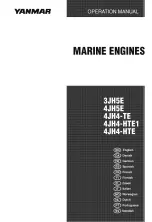
G424 Service Manual
Lubrication System
107
Testing & Adjusting
Adhere to the following warnings when performing any
tests or adjustments while the engine is running.
Work carefully around an engine that is running.
Engine parts that are hot, or parts that are moving,
can cause personal injury.
Exhaust fumes contain carbon monoxide (CO) which
can cause personal injury or death. Start and operate
the engine in a well ventilated area only. In an
enclosed area, vent the exhaust to the outside.
Engine Oil
Engine Oil Recommendation
The following oil specifications provide the guidelines
for the selection of commercial products :
Use gasoline engine oil. Recommended API service
classification is class SJ grade.
NOTICE
Failure to follow the oil recommendations can cause
shortened engine life due to carbon deposits or
excessive wear.
Prior to changing oil, select an oil based on the
prevailing daytime temperature in the area in which
the engine is operated. The chart in figure is a guide to
selection the proper crankcase oil.
IMPORTANT : Oils containing “solid” additives, non-
detergent oils, or low-quality oils are not
recommended for use in G424 Engine.
Engine Oil Viscosity Recommendation
NOTE : In normal case, the recommended engine oil
for G424 engine is SAE 10W - 30.
But, if the excessive valve noise occurs up to five
minutes after a cold start and if the maximum ambient
temperature is lower than 10°C (50°F), it is
recommended to change engine oil to SAE 5W - 30 for
that application.
Synthetic Oils
Synthetic engine oils are not recommended for use in
G424 Engine. Synthetics may offer advantages in
cold-temperature pumpability and high-temperature
oxidation resistance.
However, synthetic oils have not proven to provide
operational or economic benefits over conventional
petroleum-based oils in G424 Engine. Their use does
not permit the extension of oil change intervals.
Lubrication System Problems
One of the problems in the list that follows will
generally be an indication of a problem in the
lubrication system for the engine.
I
Too much oil consumption.
I
Low oil pressure.
I
High oil pressure.
I
Too much component wear.
Too Much Oil Consumption
I
Engine outside oil leakage
Check for leakage at the seals at each end of the
crankshaft. Look for leakage at the oil pan gasket and
all lubrication system connections. Check to see if oil
comes out of the crankcase breather. This can be
caused by combustion gas leakage around the
pistons. A dirty crankcase breather will cause high
pressure in the crankcase, and this will cause gasket
and seal leakage.
I
Combustion area oil leakage
Oil leakage into the combustion area of the cylinders
can be the cause of blue smoke. There are three
possible ways for oil leakage into the combustion area
of the stems.
1. Oil leakage between worn valve guides and valve
stems.
2. Worn or damaged piston rings, or dirty oil return
holes.
3. Compression ring and/or intermediate ring not
installed correctly.
WARNING
WARNING
Barometric temperature
SAE 10W-30
SAE 5W-30
SAE 15W-40
Summary of Contents for G424 Gasoline
Page 24: ...G424 Service Manual Engine System 23 Gasoline Engine ...
Page 25: ...G424 Service Manual Engine System 24 LPG Engine Low Emission Version ...
Page 30: ...G424 Service Manual Engine System 29 LPG Engine Low Emission Version ...
Page 32: ...G424 Service Manual Engine System 31 Wiring Diagram LPG Engine Low Emission Version ...
















































